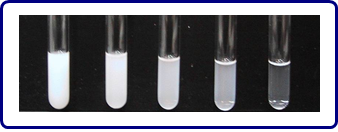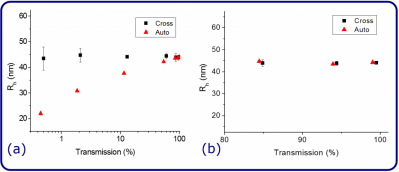Particle Sizing by 3D Cross-Correlation DLS in Highly Scattering Samples
Related Product
LS Spectrometer™ II
The LS SpectrometerTM II is a goniometer-based variable-angle light scattering instrument for static- (SLS) and dynamic light scattering (DLS). The LS SpectrometerTM II allows for the most comprehensive nanoparticle characterization and can be further upgraded with various options, such as Modulated 3D technology for the measurement of turbid samples.
Introduction
Dynamic light scattering (DLS) has become a reference technique for particle sizing applications in the range of several nanometers to several microns. This method relies on the Brownian motion of particles in solution, that when illuminated with a laser beam give rise to speckles of scattered light that fluctuate in intensity. By measuring these intensity fluctuations at high time resolution, one can obtain an autocorrelation function from which the diffusion coefficient of the particles can directly be calculated. Polydisperse samples yield a summation of diffusion coefficients that can be accurately converted to a single or even multiple mean particle sizes and their associated distributions.[1,2]

Figure 1. Typical turbid samples that can be measured with 3D DLS.
Accurate measurement of particle dynamics with DLS requires the analysis of single scattering events; even relatively limited occurrences of multiple scattering in the sample can quickly and dramatically compromise measurement results. Therefore, highly scattering and concentrated samples traditionally must be heavily diluted and tedious verification measurements must be executed to ensure data validity. It is also often the case that seemingly transparent samples exhibit multiple scattering unbeknownst to the user; without verification, significant errors in sizing measurements are therefore inevitable. Furthermore, in many cases, sample processes such as aggregation and gelation depend on high particle concentrations and so dilution is unacceptable as it modifies the very samples properties to be measured. An elegant solution to these problems is provided by the 3D cross-correlation technique which effectively suppresses the contributions of multiple scattering.[3-5]In this application note we use this powerful DLS method to enable robust measurements of particle dynamics even in nearly opaque samples having optical transmissions below 1%.
DLS Measurements
Using the 3D LS Spectrometer from LS Instruments, measurements were made for colloidal dispersions of 100 nm diameter polystyrene particles at a range of volume fractions from 0.002% up to 2.0%. A 0.1 mM salt solution was used to ensure negligible electrostatic interactions for the higher concentration samples. DLS measurements were performed in both a traditional autocorrelation mode with a single illuminating beam and single detector and subsequently in cross-correlation in the 3D geometry with two symmetrically arranged illumination beams and detectors. The hydrodynamic radius RH of the particles is automatically calculated by the software of the 3D LS Spectrometer. Five measurements of 90 s duration were repeated for each technique, all made at a scattering angle of 90º and for a sample temperature of 20.0 ± 0.1 ºC. Figure 2a illustrates the ability of the 3D cross-correlation method to accurately determine particle size for highly scattering samples while revealing the failure of traditional autocorrelation measurements for even very mildly turbid samples. Figure 2b demonstrates the excellent agreement of the two methods for transparent purely singly-scattering samples.

Figure 2. a) Hydrodynamic radius measured using auto- and 3D cross-correlation DLS for nominally 100 nm polystyrene particles at a range of volume fractions. Significant errors are present for autocorrelation measurements of turbid samples featuring low transmission; b) Linear-linear plot of the same data showing agreement of auto- and cross-correlation techniques for transparent samples.
References
[1] D.E. Koppel, Analysis of Macromolecular Polydispersity in Intensity Correlation Spectroscopy: The Method of Cumulants, J. Chem. Phys., 1972, 57 (11), 4814−4820.
[2] S. W. Provencher, Inverse problems in polymer characterization: Direct analysis of polydispersity with photon correlation spectroscopy,1979, Macromol. Chem. Phys., 180, 1, 201-209.
[3] C. Urban, P. Schurtenberger, Characterization of turbid colloidal suspensions using light scattering techniques combined with cross-correlation methods, J. Colloid Interface Sci., 1998. 207(1), 150‑158.
[4] F. Scheffold, P. Schurtenberger, Light scattering probes of viscoelastic fluids and solids, Soft Mater., 2003, 1 (2), 139-165.
[5] P.N.Pusey, Suppression of multiple scattering by photon cross-correlation techniques, Curr. Opin. Colloid. Interface Sci., 1999. 4 (3), 177-185.
